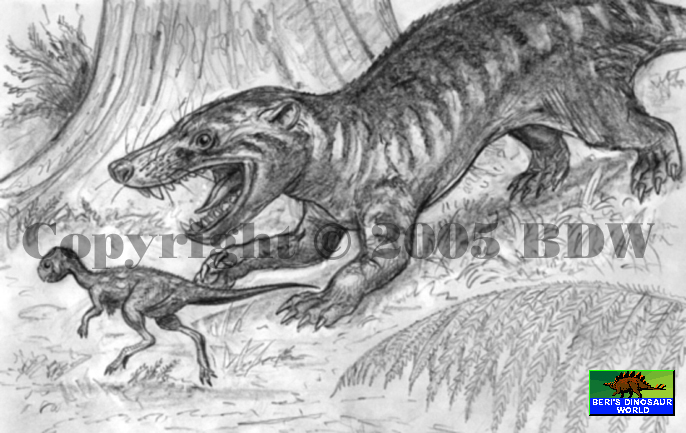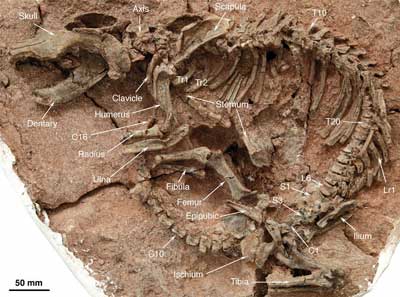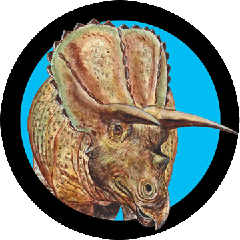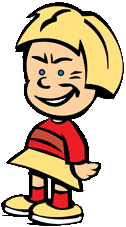| Mesozoic Mosaic pg #4 |
 Illustration of a fierce Masozoic triconodont mammal , Repenomamus robustus chasing juvenile Psittacosaurus - by Beri (graphite), Copyright ©2005 BERI Jan 2005 |
MAMMALS STRIKE BACK Repenomamus robustus - a large triconodont mammal from Early Cretaceous of China HU, Y., J. MENG, Y. WANG & C. LI. 2005. Large Mesozoic mammals fed on young dinosaurs. Nature 433: 149-152. "Mesozoic mammals are commonly portrayed as shrew- or rat-sized animals that were mainly insectivorous, probably nocturnal and lived in the shadow of dinosaurs. The largest known Mesozoic mammal represented by substantially complete remains is Repenomamus robustus, a triconodont mammal from the Lower Cretaceous of Liaoning, China. An adult individual of R. robustus was the size of a Virginia opossum. Here we report a new species of the genus, represented by a skeleton with most of the skull and postcranium preserved in articulation. The new species is 50% larger than R. robustus in skull length. In addition, stomach contents associated with a skeleton of R. robustus reveal remains of a juvenile Psittacosaurus, a ceratopsian dinosaur. Our discoveries constitute the first direct evidence that some triconodont mammals were carnivorous and fed on small vertebrates, including young dinosaurs, and also show that Mesozoic mammals had a much greater range of body sizes than previously known. We suggest that Mesozoic mammals occupied diverse niches and that some large mammals probably competed with dinosaurs for food and territory." Abstract References: 1. Large Mesozoic mammals fed on young dinosaurs Yaoming Hu, Jin Meng, Yuanqing Wang, Chuankui Li SUMMARY: Mesozoic mammals are commonly portrayed as shrew- or rat-sized animals that were mainly insectivorous, probably nocturnal and lived in the shadow of dinosaurs. The... CONTEXT: ...Cretaceous Jehol Biota from the Yixian Formation in Liaoning, China, has yielded several mammal species. Two of them, Repenomamus robustus and Gobiconodon zofiae, are from the basal member of the formation that has a radiometric...... Nature433, 149 - 152 (13 Jan 2005) Letters to Nature Abstract | Full Text | PDF 2. Mammalian palaeobiology: Living large in the Cretaceous Anne Weil SUMMARY: Discoveries of large, carnivorous mammals from the Cretaceous challenge the long-held view that primitive mammals were small and not so interesting. Have palaeontologists been asking the wrong... CONTEXT: ...of questions and speculation among palaeontologists. The dinosaur-eater belongs to a species of large mammal, Repenomamus robustus, which was described first from a skull. The new specimen is more complete — and on its left side,...... Nature433, 116 - 117 (13 Jan 2005) News and Views Full Text | PDF 3. Mammal bites dinosaur Description: 13 January 2005 Mammal bites dinosaur We tend...... CONTEXT: ...picture is changing. The extinct mammal Repenomamus robustus, discovered five years ago, broke the mould: it was much bigger, the size of a Virginia opossum. And now another member of the genus Repenomamus has been found that is...... http://www.nature.com/nature/links/050113/050113-8.html *** Some comments: "Not to take anything away from the intrinsic coolness of this find, but the idea that Mesozoic mammals might have preyed on juvenile dinosaurs is hardly astonishing. Anybody familiar with the food habits of modern small mammals would have predicted it. In fact, I suggested just such a possibility way back in 1980 on pp. 70-71 of my contribution to _A Cold Look at the Warm-Blooded Dinosaurs_. What _IS_ surprising to me is just how big the bigger Mesozoic mammals seem to have gotten, at least in some faunas!" James Farlow, Ph.D. ***"...There are at least seven teeth on each jaw quadrant of the juvenile Psittacosaurus, of which most are worn. This demonstrates that the Psittacosaurus skeleton is not from an embryo (from the paper)...""Actually, late term vertebrates are notorious for grinding their teeth, whether in a womb or in an egg, Unhatched embryos of Hypacrosaurus from Canada show worn teeth." Ken Kenneth Carpenter, Ph.D. Repenomamus holotype  A few notes on: Psittacosaurus sp. Age: Lower Cretaceous, Barremian Stage, Yixian Formation Place: Liaoning, China The psittacosaurids, known only from the late Early Cretaceous of Central Asia, are considered to be close to an ancestor of the horned dinosaurs. Both the parrot-beaked and horned dinosaurs possessed jaws, being curved and tapered forward and the lateral teeth highly specialised to masticate the vegetative food. Adult psittacosaurids were relatively small, up to 2 meters in length. They were probably mostly bipedal cursors although the forelimbs in these dinosaurs were relatively long and well-developed. |
Sunday, 9 February 2014
Repenomamus robustus - a large triconodont mammal from Early Cretaceous of China from BDW (2005)
Subscribe to:
Post Comments (Atom)




No comments:
Post a Comment